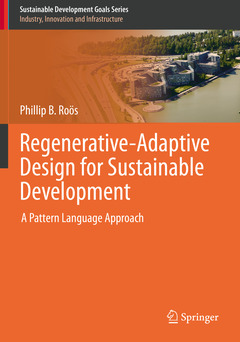Regenerative-Adaptive Design for Sustainable Development, 1st ed. 2021 A Pattern Language Approach Sustainable Development Goals Series
Auteur : Roös Phillip B.

In this book, the author tests a regenerative-adaptive pattern language theory towards investigating the possibilities of a holistic, integrated design and planning method for sustainable development that incorporates the principles of regenerative design, as well as an adaptive pattern language that re-establishes our wholeness with nature, and considers the vulnerabilities of a changing landscape. The book examines an integral approach to contemporary theories of planning and design that explores the human-nature relationship patterns in social and spatial interconnections, between people and their natural environments. The interconnectedness of human and natural systems is used to scaffold possible solutions to address key environmental and sustainability issues that specifically address the need for patterns of behaviour that acknowledge the duality of ?man and nature?.
In 12 chapters, the book presents a holistic, regenerative-adaptive pattern language that encapsulates how communities can better appreciate landscape change under future climate effects, and acknowledges the importance to adapt to patterns of change of place and the environment and therefore inform the communities? responses for sustainable development. The application of the regenerative-adaptive pattern language was tested along the Great Ocean Road region of the Victorian coast in Australia. The concluding chapters argues that for human settlements and cities to be resilient and sustainable, we must understand the interconnected patterns of human-built environments and natural systems, and how we function in a social-spatial dimension with these. The book is intended for practitioners and academic scholars with interest in sustainable development, regenerative design, pattern languages, biophilia, settlement planning, and climate change adaptation.
Dr. Phillip B. Roös is known internationally as a leader in Environmental Design. He is an ecological systems inspired architect, designer, planner and strategist for regenerative architecture, sustainable urban developments, infrastructure and landscapes. He is currently the director of the Live+Smart Research Laboratory at the School of Architecture and Built Environment, Deakin University. His research interests are centred on the human-nature relationship and the identification of optimised design processes based on a regenerative-adaptive design and pattern language system. Consequently, he has developed an integral based theory towards investigating the possibilities of a holistic integrated design and planning method that re-establishes our wholeness with nature, and considers the vulnerabilities of a changing landscape.
In professional practice he has been working as a design professional for over 30 years on an extensive range of small to large-scale projects in Europe, Africa and Australasia. His work is influenced by whole systems thinking and his application of environmental design is closely related to the ordering of the large-scale aspects of the environment by means of architecture, engineering, landscape architecture, biophilic design, urban design and ecological planning.Proposes a new theory for the sustainable development and planning of human settlements and cities
Explores the human-nature relationship patterns between people and their natural environments
Uniquely incorporates information on advanced indigenous knowledge systems
Charters a new pattern language that embeds the biophilia hypothesis within design and planning practice
Date de parution : 09-2021
Ouvrage de 247 p.
17.8x25.4 cm
Disponible chez l'éditeur (délai d'approvisionnement : 15 jours).
Prix indicatif 137,14 €
Ajouter au panierDate de parution : 09-2020
Ouvrage de 247 p.
17.8x25.4 cm
Disponible chez l'éditeur (délai d'approvisionnement : 15 jours).
Prix indicatif 137,14 €
Ajouter au panier


